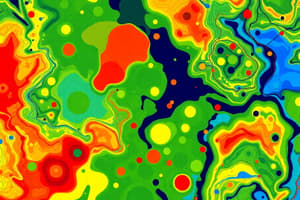Podcast
Questions and Answers
What does Tobler's First Law of Geography state?
What does Tobler's First Law of Geography state?
- Everything is related to everything else, but closer things are more related. (correct)
- Distant locations have greater relationships than nearby locations.
- Only locations within the same city have related values.
- All locations have identical relationships.
What characterizes negative spatial autocorrelation?
What characterizes negative spatial autocorrelation?
- Nearby values have identical attributes.
- Similar values are scattered, resulting in different nearby values. (correct)
- Similar values are concentrated in clusters.
- All values are randomly distributed with no pattern.
How does the pattern of ballot boxes in Georgia typically appear?
How does the pattern of ballot boxes in Georgia typically appear?
- Clustering around larger cities with more population. (correct)
- Concentrated only in rural regions.
- Randomly distributed across the state.
- Equally spaced throughout urban and rural areas.
Which analysis considers both location and a single attribute for spatial patterns?
Which analysis considers both location and a single attribute for spatial patterns?
What can influence the observed patterns of point locations over time?
What can influence the observed patterns of point locations over time?
What is the primary characteristic of positive spatial autocorrelation?
What is the primary characteristic of positive spatial autocorrelation?
Which statement is consistent with Tobler's First Law?
Which statement is consistent with Tobler's First Law?
What type of analysis is focused on the spatial relationships between two different themes or datasets?
What type of analysis is focused on the spatial relationships between two different themes or datasets?
What was the main finding from John Snow's cholera map?
What was the main finding from John Snow's cholera map?
What does Euclidean Distance represent in spatial analysis?
What does Euclidean Distance represent in spatial analysis?
Which of the following describes Network Distance?
Which of the following describes Network Distance?
What aspect does Proximity Analysis primarily focus on?
What aspect does Proximity Analysis primarily focus on?
How can spatial autocorrelation be measured?
How can spatial autocorrelation be measured?
What is the primary focus of spatial analysis?
What is the primary focus of spatial analysis?
In point pattern analysis, what does a uniform pattern indicate?
In point pattern analysis, what does a uniform pattern indicate?
Which of the following best represents a clustered pattern in point pattern analysis?
Which of the following best represents a clustered pattern in point pattern analysis?
Which method of spatial analysis focuses on the distance between similar objects or events?
Which method of spatial analysis focuses on the distance between similar objects or events?
What type of pattern is characterized by a mix of clustering and dispersion?
What type of pattern is characterized by a mix of clustering and dispersion?
What is one primary question addressed by point pattern analysis?
What is one primary question addressed by point pattern analysis?
When analyzing the correlation between surface temperature and income, what initial observation might lead to further analysis?
When analyzing the correlation between surface temperature and income, what initial observation might lead to further analysis?
How can spatial analysis be characterized in regards to variables?
How can spatial analysis be characterized in regards to variables?
Flashcards
Temporal Point Pattern Analysis
Temporal Point Pattern Analysis
Examines how the spatial distribution of data points changes over time. Helps understand if points are more clustered or dispersed compared to a previous period.
Autocorrelation Analysis
Autocorrelation Analysis
A statistical method that investigates whether similar values in a dataset tend to cluster together or are dispersed. It helps determine if there's a pattern beyond random distribution.
Tobler's First Law of Geography
Tobler's First Law of Geography
A fundamental concept in geography stating that locations closer to each other tend to have more similar characteristics than those farther apart. It emphasizes the importance of proximity in spatial analysis.
Negative Spatial Autocorrelation
Negative Spatial Autocorrelation
Signup and view all the flashcards
Positive Spatial Autocorrelation
Positive Spatial Autocorrelation
Signup and view all the flashcards
What is spatial analysis?
What is spatial analysis?
Signup and view all the flashcards
What does 'point pattern analysis' investigate?
What does 'point pattern analysis' investigate?
Signup and view all the flashcards
What is a 'uniform' point pattern?
What is a 'uniform' point pattern?
Signup and view all the flashcards
What is an 'approximate random' point pattern?
What is an 'approximate random' point pattern?
Signup and view all the flashcards
What is a 'clustered' point pattern?
What is a 'clustered' point pattern?
Signup and view all the flashcards
How can spatial analysis involve multiple variables?
How can spatial analysis involve multiple variables?
Signup and view all the flashcards
How does spatial analysis help with observations?
How does spatial analysis help with observations?
Signup and view all the flashcards
What are the applications of spatial analysis?
What are the applications of spatial analysis?
Signup and view all the flashcards
Proximity Analysis
Proximity Analysis
Signup and view all the flashcards
Euclidean Distance
Euclidean Distance
Signup and view all the flashcards
Network Distance
Network Distance
Signup and view all the flashcards
Study Notes
Spatial Analysis
- Spatial analysis goes beyond visual map reading, formalizing the exploration of patterns and relationships in geographic data.
- It's powerful, answering questions about correlations (e.g., access to transit & income, food deserts & socioeconomic factors, environmental hazards).
- Spatial analysis examines spatial patterns of objects or events (e.g., tree distribution in a city).
- It also analyzes distances and proximity between objects or events.
- Methods can be simple, focusing on a single variable, or complex, involving multiple variables.
Looking for Patterns in Spatial Data
- Human brains excel at pattern recognition. Spatial analysis helps confirm observed patterns.
- Example: Areas with cooler temperatures tend to have higher incomes than those with warmer temperatures. This suggests a possible correlation.
- Spatial analysis is used to confirm or refute these correlations.
Types of Spatial Analysis
- Point Pattern Analysis: Examines spatial arrangement of points (objects or events) and their relation in space. It helps understand how the location of one object influences the placement of others.
- Autocorrelation Analysis: Considers both location and single attributes to determine if similar values are clustered or dispersed.
- For example, are similar values (e.g., high income, high tree density) more likely to be located close together or far apart?
- Proximity Analysis: Analyzes spatial relationships between two themes or types of data. For example, the relationship between burglaries and police stations or the location of water pumps and cholera cases.
- Accessibility Analysis: Evaluates the ease of reaching a location from other locations within a transportation network. For example, travel time to ballot drop boxes in a geographic area.
Correlation Analysis
- Correlation: Does not equal causation.
- Correlation analysis assesses if a relationship (positive or negative) exists between multiple attributes.
- It helps identify clusters of extreme values. For example, areas with high tree density and high income.
- Analysis of patterns, however, doesn't necessarily imply causation. Other causes may be at play.
- Issues with correlation analysis include interoperability.
Spatial Autocorrelation
- Examines whether nearby values are systematically more similar than values that are farther apart.
- Consistent with Tobler's First Law of Geography ("everything is related to everything else, but near things are more related than distant things").
- This is examined through both continuous (e.g., income) and categorical data.
- Values vary through different times or places (often in different ways).
- Random distribution vs. clustering.
- Positive vs. negative spatial correlation and approximately random patterns.
Different types of distances
- Euclidean Distance: The straight-line distance between two points.
- Network Distance: The distance traveled along a transportation network.
- Manhattan Distance: The distance on a grid-based system.
Studying That Suits You
Use AI to generate personalized quizzes and flashcards to suit your learning preferences.




